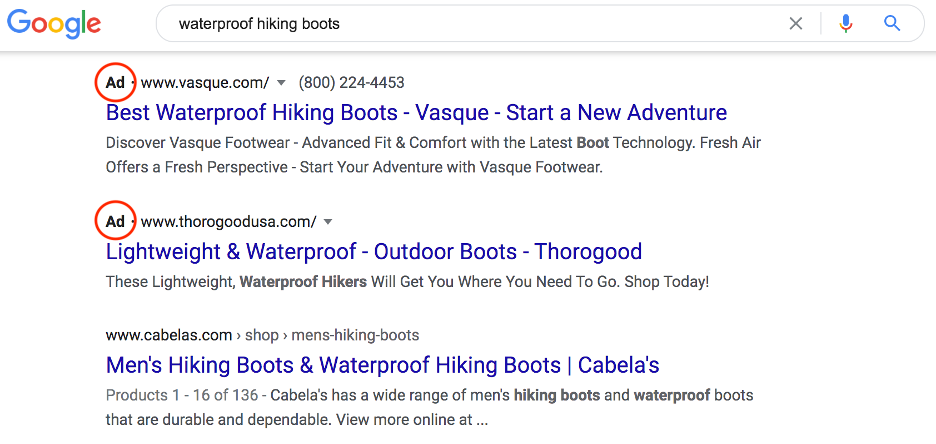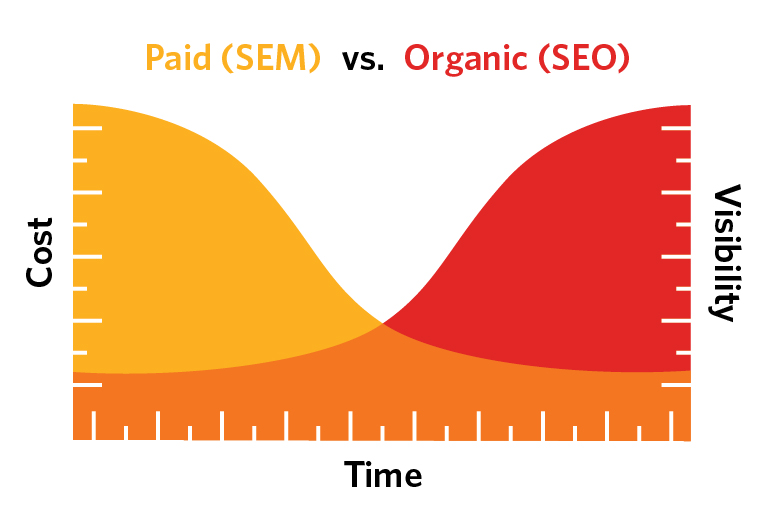



If you have any exposure to digital media or marketing, it’s highly likely that you have come across the terms “SEM” and “SEO” in your research. Both terms relate to a website’s position on the Search Engine Results Page (SERP), which is the page of listed results you see when you search for something online. There are more than 300 million active websites today, so it is understandably important for a website to be as close to the top of the SERP as possible when a user initiates a relevant search.
One of the most difficult aspects of digital marketing is qualifying leads or defining an audience to target with online ads. Search engines take this pain point away entirely. When a user initiates a search, they are telling Google, Bing or Yahoo! exactly what they are looking for—essentially self-qualifying as a lead. For example, when a user searches “best waterproof hiking boots,” it’s highly likely that the user is in the market for hiking boots. This is why a company that sells boots will spend an enormous amount of its marketing budget to try to get to the top of the SERP to capture this low-hanging fruit.
There are two ways to get to the top of the SERP: SEO and SEM.
SEO – Search Engine Optimization
Search engines have “crawlers” that go out and “read” all content on the Internet. From this data, they are able to build an index that is tied into a sophisticated algorithm. When a user initiates a search, the algorithm attempts to match the indexed data to the query in order to serve up a website that is relevant. Google processes more than 20 petabytes of data per day (a petabyte is a million gigabytes, i.e., a lot) and will prioritize websites with content that is well-organized and easy to read.
SEO is the practice of writing and adapting a website in specific ways that allow it to be more easily crawled by search engines. The easier the site is to read and index, the better chance it has of rising to the top of the SERP. SEO is the gold standard of achieving top-of-page results because once a search engine has decided it likes your website, it will continue to come up for organic results. Continued site maintenance is necessary, but SEO is by far the best way to increase the quantity and quality of users visiting your website.
Although SEO is the most long-term effective way to get to the top of the SERP, it can take some time for search engines to index your website and begin to serve it among the top results. Because of this, there is a quick and effective way to achieve first-page results right from the beginning.
SEM – Search Engine Marketing
As opposed to SEO, which helps websites make it to the top of the results page organically, SEM is a paid method through which websites or businesses can get to the top of the SERP.
Have you ever noticed that the first two or three results of your Google Search sometimes have a small Ad tag next to them? For example:

The Ad tag indicates paid results. These companies spent a good chunk of their marketing budget to have their ads come up first and second on the SERP.
The third result is for Cabela’s, a national brand specializing in hunting, fishing, camping and outdoor gear. This result is organic, achieved through SEO, and seems pretty relevant for our query. So, while the first two companies paid to be there, Cabela’s achieved a higher level of optimization and got its excellent SERP ranking without having to pay for it.
Now you can start to see why SEO is important, even though it may take a while to get the results you want.
Google and other search engines receive more than two trillion searches per year. Through paid search advertising, businesses can create ads that target only those users who are actively searching for products and services they offer. This is done through bidding on certain keywords that users may search. For the example image, it can be assumed that the top two companies are both bidding on keywords related to “hiking boots” and “waterproof.”
Search ads run on a pay-per-click (PPC) platform, meaning that advertisers are only charged if a user clicks on their ad. This creates a win-win scenario in which advertisers can get their website to the top of the SERP but are only charged if a user clicks through to their site.
For this reason, SEM is one of the best-performing digital marketing tactics available, with click-through rates averaging 2% or higher. This tactic is best for campaigns that are trying to achieve a specific and measurable user action such as online sales, survey form fills, or booking appointments.
When it comes to SEO and SEM, it is not a zero-sum game. We typically recommend starting with SEM to increase website traffic quickly while simultaneously making SEO website updates to achieve better organic results. As SEM campaigns perform well, they can actually help bolster organic results. Once SEO improves, we decrease the SEM media budget until it is no longer needed.
Hooray, Cabela’s—you’ve done it!
Now it’s your turn.

For more information or to learn more about how AcrobatAnt can help you achieve higher SERP results through SEO and SEM, give us a call or send us a note.
###
AcrobatAnt Marketing & Advertising
AcrobatAnt.com
502 S Boston
Tulsa, OK 74120
918-938-7901